Our Common Forefather
Just a Few Men Controlled
Reproduction in Prehistory and Dominate World Genetics Today
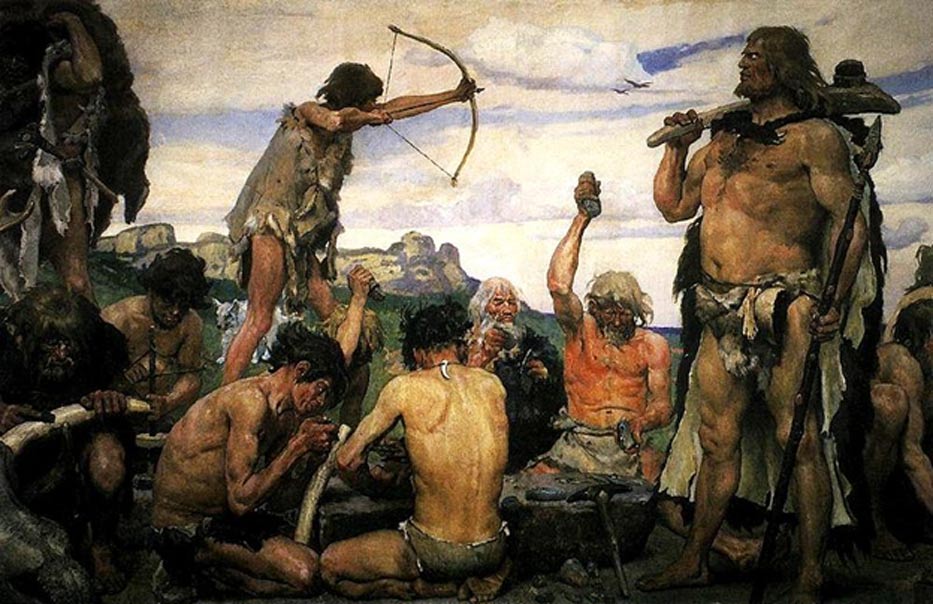
Imaginative depiction of the
Stone Age, by Viktor Vasnetsov. Source: Public Domain
By Mark Miller
A new genetic study of male ancestry shows there were periods in human prehistory when just a few elite men controlled reproduction. For example, one man about 190,000 years ago was the ancestor of 1,200 living men from 26 groups around the world whose genes were analyzed for the new study.
Who knows if that one man so long ago had great genes? Would the world have been different if it had been another man who had fathered much of the human race?
And one might also wonder just how many women this man had been with in his life. He lived at the dawn of the history of the Homo sapiens species, so perhaps just by dint of arithmetic and not necessarily by having many mates his genes came to dominate humanity.
But thousands of years later, genetic studies show, just a few men were responsible for much of the reproduction.
These tantalizing questions aren’t answered in the press release from the Wellcome Trust Sanger Institute reporting on a new study that found this ancient patriarch’s descendants are all over the world. Dr. Chris Tyler-Smith of the institute headed the study. An institute press release on the largest-ever study of the global genetic variation in the Y (male) chromosome states:
“The study … analysed sequence differences between the Y
chromosomes of more than 1200 men from 26 populations around the world using
data generated by the 1000 Genomes Project. Analysing the Y chromosomes of
modern men can tell us about the lives of our ancestors. The Y chromosome is
only passed from father to son and so is wholly linked to male characteristics
and behaviours. The team used the data to build a tree of these 1200 Y
chromosomes; it shows how they are all related to one another. As expected,
they all descend from a single man who lived approximately 190,000 years ago.”
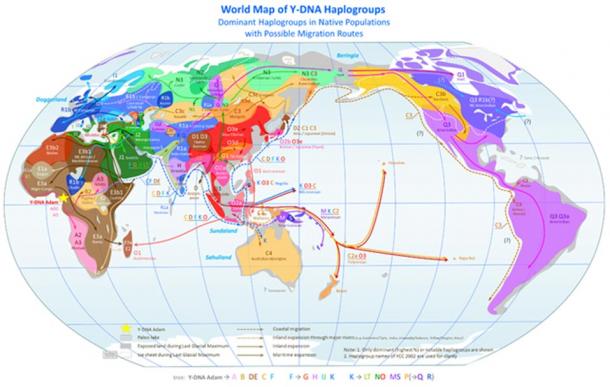
World Map of Y-Chromosome Haplogroups -
Dominant Haplogroups in Pre-Colonial Populations with Possible Migrations Routes.
(CC BY SA 3.0)
The study found an explosion in the population of males around 55,000 to 50,000 years ago in Asia and Europe and about 15,000 years ago in the Americas. Later rapid expansions of male populations happened in sub-Saharan Africa, Western Europe, South Asia, and East Asia between 8,000 and 4,000 years ago.
“The team believes the earlier population increases resulted from the first peopling by modern humans of vast continents, where plenty of resources were available,” the press release states.
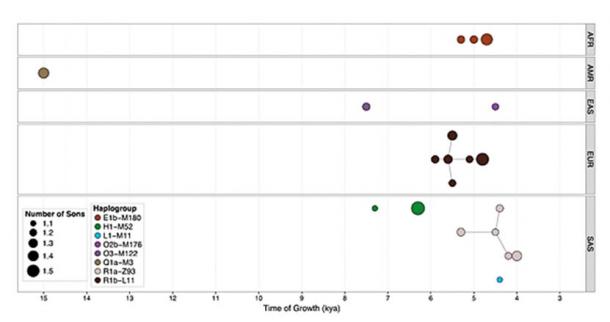
Time of haplogroup growth in different parts
of the world. (Wellcome Trust Sanger Institute)
The presence of genetic material from just a few men in the Y chromosome sequence resulted from a population explosion several thousand years ago, researchers said. The team of scientists found that there was a huge increase in the population 2,000 to 4,000 years ago, in a band from Greece and the Balkans to the British Isles and Scandinavia.
The scientists in that study also speculated that perhaps cultural and technological changes were involved in the population explosions.
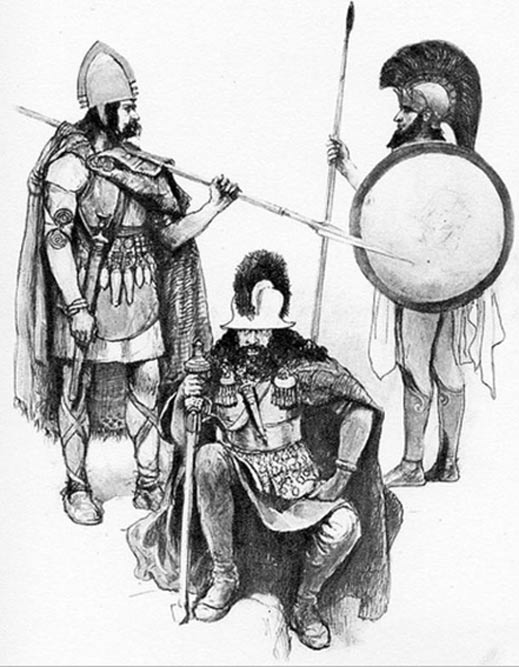
Bronze-Age warriors. (CC BY NC SA 2.0)
Most European Men are Descended from just Three Bronze Age Warlords, New Study Reveals
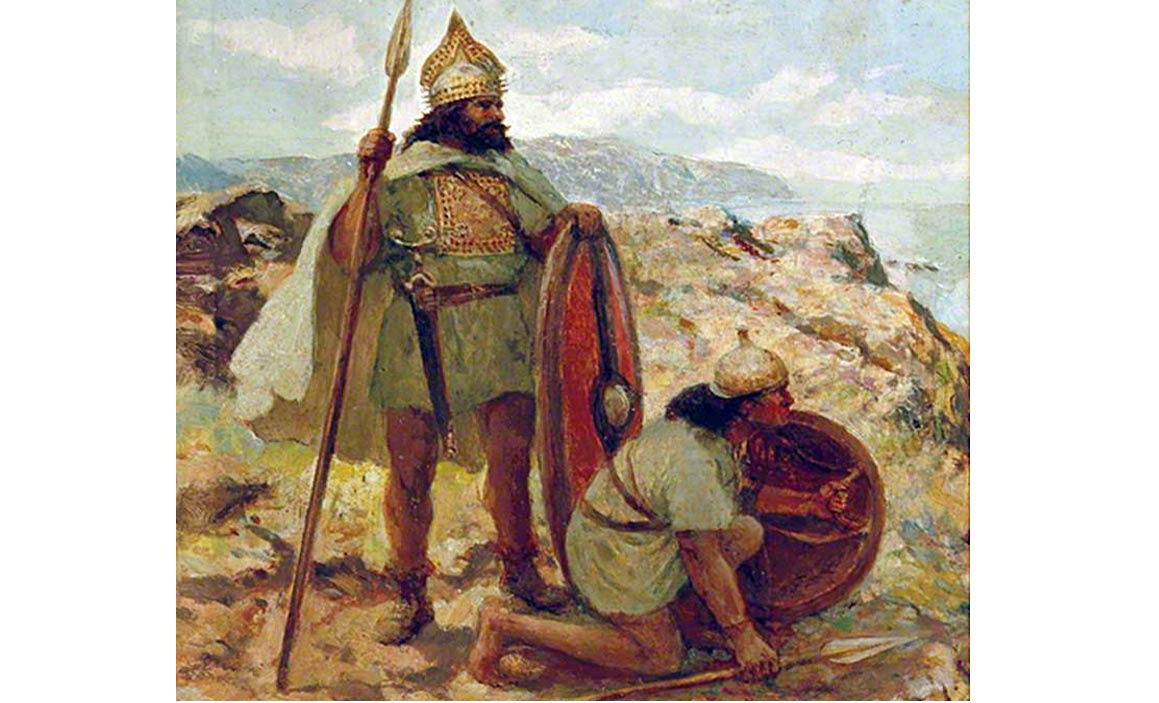
Bronze Age warriors on the lookout (Mike Bishop / Flickr)
The presence of genetic material from just a few men in the Y chromosome sequence resulted from a population explosion several thousand years ago, researchers said. The team of scientists found that there was a huge increase in the population 2,000 to 4,000 years ago, in a band from Greece and the Balkans to the British Isles and Scandinavia.
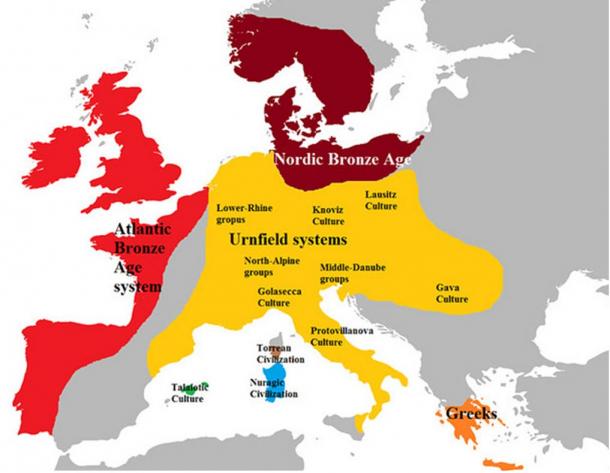
Europe in the late bronze age of about 1100
BC. (Map by Xoil, Wikimedia Commons)
"The population expansion falls within the Bronze Age, which involved changes in burial practices, the spread of horse-riding and developments in weaponry. Dominant males linked with these cultures could be responsible for the Y chromosome patterns we see today,” Jobling told Popular Archaeology.
Research into Europeans' genetic heritage had previously focused on Old Stone Age (Paleolithic) or New Stone Age (Neolithic) ancestor-farmers of about 10,000 years ago.
The principal author of the study in Nature, Chiara Batini of the University of Leicester, said: "Given the cultural complexity of the Bronze Age, it's difficult to link a particular event to the population growth that we infer. But Y-chromosome DNA sequences from skeletal remains are becoming available, and this will help us to understand what happened, and when."
A finding by researchers from Harvard Univerity in Boston found in 2014 that the European population was descended from three tribes where there was intermarrying. This study too was in the journal Nature.
The BBC, reporting on the study, said the modern European gene pool developed from the three populations within the past 7,000 years.
“Blue-eyed, swarthy hunters mingled with brown-eyed, pale skinned farmers as the latter swept into Europe from the Near East. But another, mysterious population with Siberian affinities also contributed to the genetic landscape of the continent. ... Multiple lines of evidence suggested this new way of life was spread by a wave of migrants, who interbred with the indigenous European hunter-gatherers they encountered on the way,” the BBC wrote.
The study found humans arrived in Europe about 45,000 years ago. These people were replaced by others who arrived from the Near East and the Levant about 7,000 years ago, researchers who examined ancient and modern DNA found. Researches from Harvard found most modern Europeans have a mixture of early European farmer DNA, western European hunter-gatherer DNA and some northern Eurasian ancestry.
For this study the researchers studied DNA in ancient bones of seven Scandinavian hunter-gatherers, one from Luxembourg and an ancient farmer from the area of Stuttgart, Germany and compared it to the genomes of 2,000 modern people around the world. So this was different than the more recent study by the University of Leicester, which examined just modern DNA of living men.
From Ancient Origins
@ http://www.ancient-origins.net/news-evolution-human-origins/just-few-men-controlled-reproduction-prehistory-and-dominate-world-020821?nopaging=1#sthash.oCzKaQxQ.dpuf
and http://www.ancient-origins.net/news-evolution-human-origins/most-european-men-are-descended-just-three-bronze-age-warlords-new-020361?nopaging=1#sthash.qTvxcVBJ.dpuf
For more hidden history see http://nexusilluminati.blogspot.com/search/label/hidden%20history
- Scroll down
through ‘Older Posts’ at the end of each section
Hope you like this
not for profit site -
It takes hours of work every day by
a genuinely incapacitated invalid to maintain, write, edit, research,
illustrate and publish this website from a tiny cabin in a remote forest.
Now that most viewers see these posts
on mobile devices, sites like this receive an ever diminishing amount of
revenue from advertising… less than a pittance.
Like what you see? Please give anything
you can -
Contribute any amount and receive at
least one New Illuminati eBook!
(You can use a card
securely if you don’t use Paypal)
Please click below -
Spare Bitcoin
change?
For further enlightening
information enter a word or phrase into the random synchronistic search box @
the top left of http://nexusilluminati.blogspot.com
And see
New Illuminati – http://nexusilluminati.blogspot.com
New Illuminati on Facebook - https://www.facebook.com/the.new.illuminati
New Illuminati Youtube Channel - https://www.youtube.com/user/newilluminati/playlists
New Illuminati’s OWN Youtube Videos
-
New Illuminati on Google+ @ For
New Illuminati posts - https://plus.google.com/u/0/+RamAyana0/posts
New Illuminati on Twitter @ www.twitter.com/new_illuminati
New Illuminations –Art(icles) by
R. Ayana @ http://newilluminations.blogspot.com
The Her(m)etic Hermit - http://hermetic.blog.com
DISGRUNTLED SITE ADMINS PLEASE NOTE –
We provide
a live link to your original material on your site (and links via social
networking services) - which raises your ranking on search engines and helps
spread your info further!
This site
is published under Creative Commons (Attribution) CopyRIGHT (unless an
individual article or other item is declared otherwise by the copyright
holder). Reproduction for non-profit use is permitted & encouraged - if you
give attribution to the work & author and include all links in the original
(along with this or a similar notice).
Feel free
to make non-commercial hard (printed) or software copies or mirror sites - you
never know how long something will stay glued to the web – but remember
attribution!
If you
like what you see, please send a donation (no amount is too small or too large)
or leave a comment – and thanks for reading this far…
Live long
and prosper! Together we can create the best of all possible worlds…
From the New Illuminati – http://nexusilluminati.blogspot.com
Most likely this occured after a great calamity happened on the planet. How else can we explain the age of the pyramids, given the approximate dates?
ReplyDeleteI think this new population would be a "bottleneck" phenomenon.A population bottleneck (or genetic bottleneck) is a sharp reduction in the size of a population due to environmental events.
Now, please watch the following video. It has to do with the part played by the female in this phenomenon. It might be difficult to swallow, but given the
information from the article, makes perfect sense. And something all wise humans should consider.
https://www.youtube.com/watch?v=UxpVwBzFAkw
A challenging video indeed! There were at least two bottlenecks caused by catastrophic supervolcano eruptions - aside fromm the infamous Tola event which destroyed much of humankind circa 70,000 years ago, another eruption in Italy virtually wiped out all the Neanderthal people - and most of Europe - around 40,000 years ago. But these bottlenecks are not the only explanations...
Delete